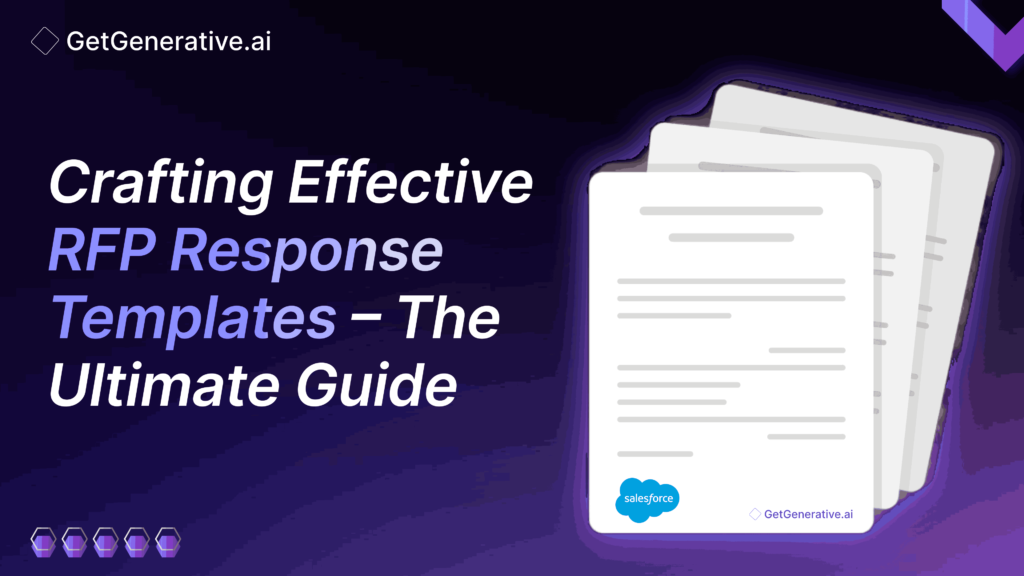RFP Response Templates – The Ultimate Guide
In today’s fast-paced business world, the ability to respond quickly and effectively to requests for proposals (RFPs) can set your company apart from the competition. With the average proposal team submitting over 162 RFP responses annually, a well-structured RFP response template is more than a convenience—it’s necessary.
In this blog, we’ll explore the key elements of a successful RFP response template, how to customize it to meet your client’s needs and the tools that can help streamline your proposal process.
What is an RFP Response Template?
An RFP response template is a meticulously crafted document that serves as a foundational blueprint for responding to proposal requests. It is designed to streamline the proposal creation process, enabling your team to produce high-quality, tailored responses that align with potential clients’ needs and requirements.
Explore – What Is RFP and How to Navigate It
Key Benefits of Using an RFP Response Template
1. Structured Framework for Consistency:
Using a template ensures that your proposals maintain a consistent format and structure. This uniformity is crucial, especially when multiple team members contribute to the response. It helps present a cohesive and professional document, making it easier for evaluators to follow and understand your proposal.
2. Pre-filled Information:
The template includes pre-filled answers to common questions and standard sections such as company history, qualifications, and success stories. This reduces the time spent on repetitive tasks, allowing your team to focus on customizing the content to address each RFP’s specific concerns and requirements.
3. Customization and Flexibility:
While the template provides a standard framework, it also offers flexibility for customization. Each RFP has unique aspects, and the template allows you to tailor your responses to highlight how your solutions specifically meet the client’s needs. This balance of standardization and customization is key to producing effective proposals efficiently.
4. Enhanced Collaboration:
The RFP response template fosters better collaboration among team members and subject matter experts (SMEs). By providing a clear structure and predefined sections, team members can easily understand their roles and contributions, ensuring a more organized and coordinated effort in crafting the proposal.
5. Compliance and Accuracy:
With a well-structured template, you can ensure that your responses comply with the RFP requirements and industry standards. It minimizes the risk of overlooking critical information and helps maintain accuracy in your responses, essential for building trust and credibility with potential clients.
Key Components of an Effective RFP Response Template
A comprehensive RFP response template typically includes the following sections:
- Cover Letter: This section serves as the introduction to your proposal, setting the tone and context. It should be engaging and professional, expressing your enthusiasm for the project and briefly outlining your understanding of the client’s needs and how your company is uniquely positioned to meet them.
- Executive Summary: A concise overview of your proposal that highlights your strategic approach and unique selling points. It should focus on the client’s key concerns and demonstrate how your solution provides a clear and compelling benefit.
- Company Qualifications: This section provides a detailed overview of your company’s background, including its history, core values, team qualifications, and relevant experience. Use this section to build credibility and showcase your company’s ability to deliver on the proposed project.
- Proposed Solution: Here, you’ll detail your approach to addressing the client’s needs. This includes a comprehensive implementation plan, key deliverables, project timelines, and all parties’ roles. Be specific about how your solution aligns with the client’s goals and requirements.
- Pricing Details: Transparent pricing is crucial. Break down the costs into categories (e.g., labor, materials, overhead) and provide clear payment terms. Include any potential discounts or incentives, but avoid underselling your services.
- Success Stories: Use case studies and testimonials from past clients to demonstrate your company’s track record of success. Choose examples that closely align with the client’s industry or specific challenges to make them more relatable and impactful.
- Terms and Conditions: Outline the contractual terms, including the rights and responsibilities of both parties, potential risks, and contingency plans. This section ensures that all parties clearly understand the agreement and helps prevent misunderstandings.
Integrating these elements into your RFP response template creates a powerful tool that enhances your team’s efficiency and effectiveness in producing high-quality proposals. This strategic approach saves time and increases your chances of winning new business by delivering tailored, professional, and persuasive responses to RFPs.
Customizing Your RFP Response Template
Customizing your RFP response template is crucial for creating a proposal that stands out and meets each client’s specific needs. A generic response may fail to resonate with the client, while a tailored response demonstrates your deep understanding of their unique requirements and challenges. Here are four detailed steps to ensure your RFP response is customized effectively:
1. Research the Client to Understand Their Needs
Thoroughly researching the client and their industry is the first step in customization. This enables you to tailor your response to their goals, pain points, and expectations. Here’s how to gather this insight:
- Analyze the RFP Document: Carefully read the RFP document multiple times. Note any specific requirements, preferred formats, and evaluation criteria. Highlight key sections that need special attention.
- Direct Communication: Please arrange conversations with the key decision-makers or the contact person in the RFP. Use these discussions to understand their primary concerns and priorities.
- Website and Marketing Materials: Review the client’s website, blog posts, press releases, and marketing collateral. These can provide valuable information about the company’s current initiatives, corporate culture, and market positioning.
- Competitor Analysis: Research the client’s competitors and the incumbent vendor (if any). Understanding the competitive landscape can help you identify your unique value proposition and areas where you have an advantage.
2. Collaborate With Subject Matter Experts (SMEs)
Engaging SMEs within your organization ensures that your proposal is accurate, detailed, and reflects your company’s expertise. Here’s how to effectively collaborate with SMEs:
- Kickoff Meetings: Host a kickoff meeting with your SMEs to discuss the RFP, the potential client, and the project’s importance. Share your insights from the research phase to align everyone on the client’s needs.
- Drafting Support: Prepare initial drafts of the answers for the SMEs to review. This saves them time and makes providing detailed and accurate information easier.
- Content Guidelines: Provide clear guidelines and examples of previous successful RFP responses. This helps SMEs understand the expected quality and format of their contributions.
- Flexible Communication: Determine each SME’s preferred communication style. Some prefer emails, while others are more responsive to phone calls or video meetings. Adapt your approach to ensure smooth collaboration.
Also Read – RFP, RFQ, RFI: Navigating the Complex World of Procurement Processes
3. Use Graphics to Enhance the Proposal
Visual elements can significantly improve the readability and impact of your proposal. They help communicate complex information succinctly and make your proposal more engaging. Here’s how to incorporate graphics effectively:
- Data Visualization: Use pie charts, bar graphs, and line charts to present quantitative data such as business growth, financial projections, or success metrics. Visuals can make data more accessible and memorable.
- Comparison Tables: Create tables to compare your solution’s features and benefits against competitors or the incumbent. Highlighting your unique advantages visually can be more persuasive than text alone.
- Project Timelines: Develop a timeline graphic to illustrate your proposed project plan. This will help the client understand the project’s phases, key milestones, and expected delivery dates.
- Infographics: Design infographics to summarize complex processes or workflows. Infographics can break down complicated information into digestible and visually appealing sections.
4. Make the Proposal Clear, Compelling, and Concise
Editing your proposal to be clear, compelling, and concise ensures that your message is easily understood and impactful. Here’s how to achieve this:
- Clear Language: Avoid jargon and overly technical language unless it is necessary and understood by the client. Use straightforward language to convey your message.
- Engaging Content: Focus on what makes your proposal compelling. Highlight your unique selling points, competitive advantages, and the benefits your solution offers the client. Use storytelling techniques to make your case studies and success stories more engaging.
- Concise Writing: Eliminate unnecessary words and redundancies. Ensure each sentence serves a purpose and adds value to the proposal. Use bullet points and subheadings to break up text and make scanning easier.
- Proofreading and Editing: Use tools like Grammarly or the Hemingway App to check for spelling, grammar, and readability issues. Have a team member not involved in writing the proposal review it for clarity and coherence. Reading the proposal out loud can also help catch awkward phrasing or inconsistencies.
By following these detailed steps, you can customize your RFP response template to create tailored, professional, and persuasive proposals. This approach increases your chances of winning new business and builds stronger relationships with potential clients by demonstrating your commitment to understanding and addressing their unique needs.
Tools to Speed Up Your Proposal Process
Leveraging the right tools can dramatically reduce the time and effort required to create high-quality proposals. Here are two key tools that can help:
- Sales Proposal Platform: A sales proposal platform or software can streamline the RFP response process. These platforms often include features like auto-suggesting answers from past RFPs, assigning questions to SMEs, and maintaining a content library for easy access to frequently used information.
- Generative AI: Generative AI can be a game-changer when creating RFP responses. It can help you build a custom content plan, summarize executive bios, and draft initial responses quickly, giving you a strong starting point to refine and customize.
Conclusion
A well-crafted RFP response template is an invaluable asset for any proposal team. By incorporating the key components outlined above and leveraging advanced tools like sales proposal platforms and generative AI, you can create compelling, tailored responses that increase your chances of winning new business.
Remember, your RFP response aims to make the client feel understood and confident in your ability to deliver. You can achieve this consistently and efficiently with a solid template and the right tools.
Sign up with GetGenerative.ai today and start crafting impressive proposals quickly. Streamline your process and spend more time on what’s important. Ideal for Salesforce consultants ready to enhance their performance.
Act now—discover the next level of Salesforce consulting with GetGenerative.ai!
Frequently Asked Questions (FAQs)
1. What is an RFP response template?
An RFP response template is a pre-structured document that helps streamline the response to proposal requests by providing repeatable answers in a consistent format.
2. Why should I use an RFP response template?
Using an RFP response template saves time, ensures consistency, and allows your team to focus on customizing responses to meet each client’s specific needs.
3. What are the key components of an RFP response template?
Key components include a cover letter, executive summary, company qualifications, proposed solution, pricing details, success stories, and terms and conditions.
4. How do I customize an RFP response template?
Customize your template by researching the client, collaborating with SMEs, using graphics, and editing for clarity and impact.
5. What tools can help speed up the RFP response process?
RFP response software and generative AI can help streamline the process by suggesting answers from past RFPs, automating content upkeep, and drafting initial responses.




